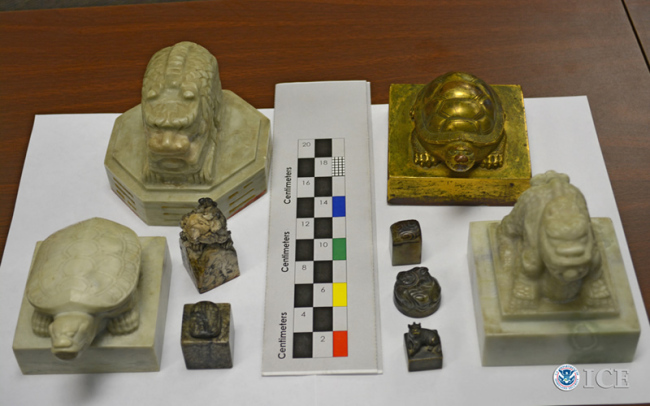
Junmyeongjibo (far left, front row); Hwangjejibo (far right, front row); Sugangtaehwangjebo (far left, back row); Yuseojibo (far right) and five other Daehan Empire signets seized by the U.S. customs agency in California, Tuesday. (U.S. Immigration and Customs Enforcement)
Priceless national and royal seals from the Daehan Empire (1897-1910) have been seized in California by U.S. authorities.
When they are returned, which could be as early as next June, the artifacts will be the most valuable items of cultural heritage to be repatriated to Korea to date, the Cultural Heritage Administration said Wednesday.
According to the U.S. Immigration and Customs Enforcement’s Homeland Security Investigations unit and Korea’s Cultural Heritage Administration, the items confiscated Monday include three national seals and one royal seal of the Daehan Empire and five signets of the Joseon royal court. The Daehan Empire succeeded the Joseon Kingdom.
National seals and royal seals are the two main types of seals made by the Korean government. National seals were made for practical use, mostly for official government documents.
Royal seals were carved to commemorate royal rituals. Among the seals seized are Hwangjejibo (Seal of the Emperor), the national seal made upon the establishment of the Daehan Empire in 1897, and Sugangtaehwangjebo (Royal Seal of ex-Emperor Sugang), the royal seal carved to commemorate a 1907 royal rite bestowing Emperor Gojong (1897-1907) with the honorary title of Great Emperor Sugang after his abdication.
Both Yuseojibo (Seal of Yuseo) and Junmyeongjibo (Seal of Junmyeong) were used for official purposes such as appointing government officials. Five other signets were used to stamp on the books or paintings in the Joseon Royal court.
“The nine Korean seals recovered by HSI special agents are worth millions in the antiquities business, but they are priceless to South Korea,” said HSI Attache Seoul Taekuk Cho in a press release.
Seo Joon, researcher at the National Palace Museum, noted that the national seals will be invaluable since there are only three remaining in Korea at the moment.
“National seals are the face of the nation. Therefore, losing it is a grave matter but throughout the history, during invasions, there are signs of theft and looting,” he said.
“The U.S. has been strict about looted cultural heritage and we are very positive that the seals, which have clearly never been allowed to be removed from the royal palace, will return to Korea. The repatriation will be the recovery of the face of Daehan Empire,” he said.
The seizure came as a joint investigative team of U.S. and Korean authorities probed an alert made by a Washington-based antiques dealer who was approached by the family of a deceased Marine lieutenant, who had served in the Korean War (1950-1953.) The man is believed to have found the seals in 1950 in a ditch near the Deoksugung Palace, which had just been ransacked by Chinese and North Korean soldiers.
Korea and HIS, which investigates illegal importation and distribution of cultural property including the illicit trafficking of cultural property, have been collaborating in a number of cases including the August repatriation of Hojotaehwangwon currency printing plate manufactured in 1892.
“The government will conduct a thorough investigation into artifacts overseas that may have been looted. We expect more joint investigations and cooperation in the future,” a CHA official said.
Civic activists have called on the government to put more efforts into tracing cultural assets that are overseas, removed from the country through illegal routes. Ven. Hyemun, a Buddhist monk who heads an NGO working to repatriate Korean cultural artifacts, on Wednesday criticized the government’s “ignorance.”
“In 2010 we found the U.S. government’s investigative documents concerning its soldiers’ theft of Korean cultural heritage. And it was shocking that the Korean government wasn’t aware of it at all,” he told The Korea Herald.
“Even if the nine artifacts are returned to Korea, there are still about 30 royal or national signets assumed to be in the U.S. We need to find them,” he said.
The artifacts are likely to be returned to Korea as early as June next year after the U.S. authorities complete the investigation and confirm the origin of the items.
By Bae Ji-sook (
baejisook@heraldcorp.com)






![[Graphic News] More Koreans say they plan long-distance trips this year](http://res.heraldm.com/phpwas/restmb_idxmake.php?idx=645&simg=/content/image/2024/04/17/20240417050828_0.gif&u=)